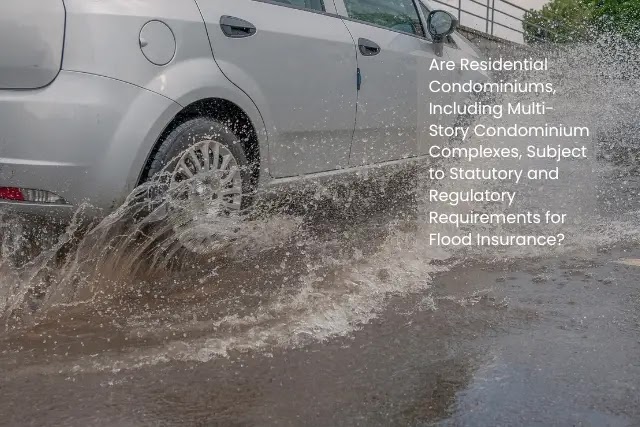Introduction:
In recent years, the issue of flood insurance has gained increasing prominence, particularly in the context of residential condominiums, including multi-story condominium complexes. As climate change continues to manifest itself through rising sea levels and increased precipitation, the risk of flooding has become a pressing concern for property owners and policymakers alike.
This article delves into a critical question: Are residential condominiums, particularly mu, subject to statutory and regulatory requirements for flood insurance? Understanding the implications of flood insurance regulations on such properties is vital for the financial security of homeowners and associations and for ensuring community resilience in the face of potential natural disasters. In this examination, we will explore the legal and regulatory landscape governing flood insurance for residential condominiums, shedding light on its significance and potential consequences.
- Legal Framework for Flood Insurance in Residential Condominiums
- Obligations of Condo Associations and Unit Owners
- FEMA Regulations and Flood Zone Designations
- Insurance Coverage Options and Considerations
- Consequences of Non-Compliance with Flood Insurance Requirements
- Mitigation Strategies for Flood Risk Reduction in Condos
Legal Framework for Flood Insurance in Residential Condominiums:
The legal framework surrounding flood insurance in residential condominiums is multifaceted and often involves federal, state, and local regulations. At the federal level, the Federal Emergency Management Agency (FEMA) plays a central role in establishing flood insurance requirements. FEMA’s guidelines dictate that residential condominiums, including multi-story complexes, may be subject to flood insurance requirements if they are located in designated Special Flood Hazard Areas (SFHAs). These SFHAs are typically delineated on Flood Insurance Rate Maps (FIRMs), which identify areas at risk of flooding.
In addition to FEMA regulations, state and local governments may have their own flood insurance requirements and zoning ordinances that affect residential condominiums. The specific legal framework can vary significantly from one jurisdiction to another. Typically, these regulations stipulate the minimum requirements for flood insurance coverage, and they may impose obligations on condo associations and individual unit owners to obtain and maintain adequate policies.
Obligations of Condo Associations and Unit Owners:
Condo associations and individual unit owners each bear distinct responsibilities concerning flood insurance. Condo associations, acting on behalf of the collective interests of the unit owners, are typically responsible for obtaining a master flood insurance policy that covers common areas and the building’s structure. These policies help ensure that vital components of the condominium complex, such as the foundation and common utilities, are protected in the event of flooding. Unit owners, on the other hand, are generally required to secure their own insurance policies to cover personal property and improvements made within their units.
The obligations of condo associations and unit owners may be outlined in the condominium’s governing documents, which can vary widely from one condominium association to another. Additionally, the level of insurance required and the allocation of costs among unit owners may be subject to state laws and regulations. Understanding these obligations is crucial for both condo associations and unit owners to ensure compliance with legal requirements and to adequately protect their investments.
FEMA Regulations and Flood Zone Designations:
FEMA regulations and flood zone designations are pivotal components of flood insurance requirements for residential condominiums. FEMA designates flood-prone areas into various flood zones based on the likelihood and severity of flooding. The most common designation is the Special Flood Hazard Area (SFHA), where properties are at high risk of flooding. Condominiums located within SFHAs are typically subject to mandatory flood insurance requirements.
To determine whether a residential condominium is within an SFHA, FEMA provides Flood Insurance Rate Maps (FIRMs) that outline these zones. Condo associations and unit owners must consult these maps and FEMA’s guidelines to assess their flood risk and insurance obligations accurately. FEMA’s regulations also include guidelines on the elevation of structures, which can affect insurance rates and requirements, particularly in high-risk flood zones.
Insurance Coverage Options and Considerations:
Residential condominiums have several insurance coverage options to consider when addressing flood risks. For condo associations, obtaining a master flood insurance policy is often a primary consideration. This policy typically covers the building’s structure, common areas, and shared utilities. Unit owners, on the other hand, should evaluate their individual insurance needs, which may include coverage for personal belongings, appliances, and any improvements made to their units.
When selecting insurance coverage, it’s essential to consider factors such as the property’s location within a flood zone, the potential cost of rebuilding or repairing damaged structures, and the value of personal property. Policyholders should also be aware of coverage limits, deductibles, and waiting periods, as these can vary between policies and insurers. Understanding the nuances of coverage options is crucial for both condo associations and unit owners to ensure they have adequate protection in the event of a flood.
Consequences of Non-Compliance with Flood Insurance Requirements:
Non-compliance with flood insurance requirements can have significant consequences for residential condominiums. In high-risk flood zones, failing to maintain flood insurance coverage can result in legal penalties and fines imposed by federal, state, or local authorities. Furthermore, without adequate insurance, condo associations and unit owners may find themselves facing substantial financial burdens in the aftermath of a flood event, as they will be responsible for repairing and rebuilding damaged property out of their own pockets.
Beyond legal and financial consequences, the failure to comply with flood insurance requirements can jeopardize the safety and well-being of residents. In flood-prone areas, the risk of severe property damage and displacement in the absence of insurance can be a daunting prospect. Therefore, understanding the importance of compliance and the potential ramifications of non-compliance is essential for all stakeholders involved in residential condominiums.
Mitigation Strategies for Flood Risk Reduction in Condos:
Mitigating flood risks in residential condominiums is a proactive approach to reducing potential damage and minimizing insurance costs. Condo associations can implement various strategies to reduce flood risk, such as elevating buildings, installing flood-resistant materials, and implementing proper drainage systems. These measures not only enhance the resilience of the condominium complex but may also lead to lower flood insurance premiums.
Individual unit owners can also take steps to mitigate flood risks within their units by elevating appliances and personal belongings, sealing entry points vulnerable to water intrusion, and staying informed about local flood warnings and evacuation plans. Additionally, both condo associations and unit owners can explore FEMA’s Community Rating System (CRS), which offers incentives for communities that go above and beyond minimum floodplain management requirements to reduce flood risks.
Understanding the statutory and regulatory requirements for flood insurance in residential condominiums, including multi-story complexes, is vital for both condo associations and individual unit owners. Complying with these requirements not only ensures legal and financial protection but also contributes to the safety and security of residents. Moreover, proactive mitigation strategies can help reduce flood risks, ultimately leading to more resilient and sustainable condominium communities.
Conclusion:
I hope that this exploration of the statutory and regulatory requirements for flood insurance in residential condominiums, including multi-story complexes, has shed light on the intricacies and significance of this critical issue. As the frequency and intensity of flooding events continue to rise due to climate change, compliance with these requirements is paramount for both condo associations and individual unit owners.
In conclusion, residential condominiums are indeed subject to a complex legal framework governing flood insurance, encompassing federal, state, and local regulations. FEMA’s flood zone designations and insurance guidelines play a central role in determining these requirements. Failure to comply can result in legal penalties, financial hardship, and, most importantly, the potential endangerment of residents.
To ensure the safety, financial security, and legal compliance of all stakeholders, it is essential for condominium communities to remain informed about their flood risk, proactively implement mitigation strategies, and maintain the appropriate insurance coverage. By doing so, residential condominiums can navigate the challenges of flood insurance with greater resilience and preparedness in an increasingly unpredictable climate.

